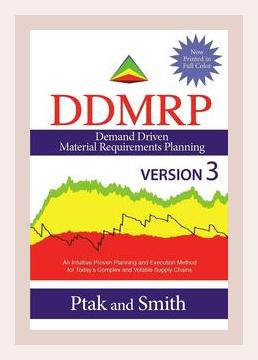Operations and Supply Chain ManagementInventory Management
Title: Demand Driven Material Requirements Planning (DDMRP)
Authors: Carol Ptak, Chad Smith
Publication Year: 2018
Category: Inventory Management
Introduction
Demand Driven Material Requirements Planning (DDMRP) delves into a modern and progressive approach to managing materials and inventory in a way that adapts to real-time market demands. Ptak and Smith argue that traditional Material Requirements Planning (MRP) systems are inadequate in today’s volatile, uncertain, complex, and ambiguous (VUCA) environment. DDMRP, as detailed in the book, aims to fill this gap by integrating demand-driven techniques to improve the performance of supply chains.
1. The Need for Change
Problem with Traditional MRP: Traditional MRP systems were designed in an era where demand was much more predictable. Ptak and Smith point out that these systems rely heavily on forecast accuracy, which is an increasingly unreliable approach in the current market environment. High variability and longer lead times add to the complexity, resulting in ineffective inventory levels and increased costs.
Example: A manufacturer of electronic components experienced frequent stockouts and overstock situations despite using traditional MRP systems. This inconsistency led to unmet customer demands and high holding costs.
Action: Assess the variability and demand patterns within your supply chain to understand the limitations of your current MRP system. Consider realigning your inventory management strategy to accommodate more agile and responsive methods.
2. Key Principles of DDMRP
Five Components of DDMRP: The authors introduce the five key components of DDMRP:
1. Strategic Inventory Positioning: Identifying key stocking points.
2. Buffer Profiles and Levels: Establishing dynamic inventory levels.
3. Dynamic Adjustments: Adjusting buffer levels in real-time based on market conditions.
4. Demand-Driven Planning: Using actual demand to drive replenishment.
5. Visible and Collaborative Execution: Integrating visibility and collaboration in the execution phase.
Example: A retail company implemented DDMRP by strategically positioning inventory at distribution centers closer to end consumers rather than at a centralized warehouse. This repositioning reduced lead times and improved service levels.
Action: Map out your supply chain to identify critical points where buffering inventory could mitigate variability and delay. Determine buffer levels through historical data and expected demand patterns.
3. Strategic Inventory Positioning
Critical Inventory Locations: The book explains the importance of positioning inventory at points that can yield the greatest impact on the flow of the supply chain. These points are typically decoupling points where the stocked product is differentiated based on customer order.
Example: A bicycle manufacturer placed strategic buffers at assembly plants instead of at parts suppliers. This helped manage the flow of components more effectively while maintaining agility in the assembly process.
Action: Conduct a thorough analysis of your supply chain to identify decoupling points where inventory can be positioned to absorb demand and supply variability effectively.
4. Buffer Profiles and Levels
Establishing Buffer Levels: The book emphasizes dynamic buffer levels rather than static ones. Buffer levels should be designed based on factors like lead time, variability, supply reliability, and demand fluctuations.
Example: An industrial goods manufacturer segmented buffers into green (low risk), yellow (moderate risk), and red (high risk) zones. This stratification allowed immediate visual identification of inventory hot spots.
Action: Develop buffer profiles based on your product types and volatility. Use historical data to determine the initial buffer sizes and adjust them dynamically as per changing conditions.
5. Dynamic Adjustments
Adaptation to Market Changes: Dynamic adjustments are vital in ensuring that buffer levels remain appropriate in the face of changing market demands and supply conditions. This component requires constant monitoring and real-time data.
Example: An automotive parts supplier used software tools to adjust buffer levels based on real-time sales data and supplier lead time variability. This approach minimized stockouts and overstock situations.
Action: Invest in software solutions that can assist in real-time data monitoring and automatic buffer adjustments. Regularly review buffer performance to ensure alignment with market conditions.
6. Demand-Driven Planning
Using Actual Demand: Instead of relying on forecasts, Ptak and Smith advocate for planning based on actual orders and consumption. This approach reduces the bullwhip effect and improves inventory turnover.
Example: A skincare products manufacturer shifted to DDMRP and began planning production cycles based on actual sales data rather than forecasted demand, resulting in more accurate inventory levels and reduced wastage.
Action: Shift from forecast-driven to demand-driven planning by closely monitoring sales and consumption data. Implement systems that can respond quickly to actual demand signals.
7. Visible and Collaborative Execution
Enhanced Visibility: Effective DDMRP implementation requires visibility and collaboration across the supply chain. Sharing real-time data among stakeholders helps in preemptive actions rather than reactive ones.
Example: A consumer electronics company established a digital platform where suppliers, manufacturers, and retailers could share real-time inventory data, leading to better aligned and proactive inventory management.
Action: Foster a culture of transparency by using shared digital platforms for inventory management. Encourage collaboration among different supply chain partners to improve decision-making processes.
Conclusion
Demand Driven Material Requirements Planning (DDMRP) offers a revolutionary approach to inventory management, shifting from forecast-driven to demand-driven methodologies. By strategically positioning inventory, establishing dynamic buffers, making real-time adjustments, planning based on actual demand, and enhancing visibility and collaboration, organizations can significantly improve their supply chain efficiency. Ptak and Smith’s comprehensive guide provides concrete examples and actionable steps, making it a valuable resource for any entity looking to modernize its inventory management practices.
Further Action Steps
- Training and Education: Educate team members and key stakeholders about DDMRP principles and their benefits.
- Pilot Programs: Start with a pilot implementation in a small segment of your supply chain to validate the approach and make necessary adjustments.
- Continuous Improvement: Regularly review and refine DDMRP practices to adapt to evolving market conditions and organizational needs.
